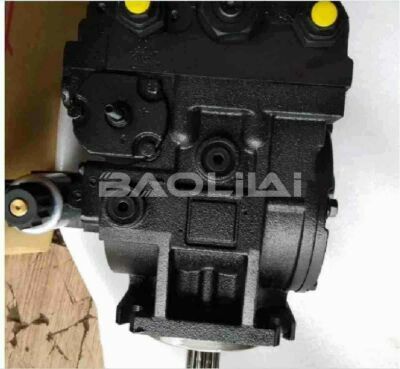Key issues and solutions to prevent puncture cracks in plunger pump heads
There are many reasons for puncture cracks in the plunger pump head, which need to be analyzed and solved in detail. Here are some common causes and possible solutions:
1. Material fatigue:
Reason: Repeated stress cycles on the plunger can cause material fatigue over time.
Solution: Consider using a material with higher fatigue resistance or inspect and replace the plunger regularly to prevent failure.
2. Corrosion:
Reason: Contact with corrosive liquids or harsh environmental conditions can cause corrosion, weakening the plunger's performance.
Solution: Use a corrosion-resistant material or implement a protective coating on the plunger. Check and maintain the pump regularly to prevent corrosion.
3. Improper lubrication:
Reason: Insufficient lubrication will increase friction and wear of the plunger, leading to cracks.
Solution: Ensure proper lubrication of pump components. Follow the manufacturer's recommendations for frequency and type of lubrication.
4. Excessive pressure:
Reason: Operating a pump at pressures beyond its design limits may cause structural failure.
Solution: Run the pump within the specified pressure range. If higher pressure is required, consider upgrading to a pump designed for these conditions.
H1-P-069-R-A-A-A2-C2-N-D6-H-G1-H3-L-33-L-33-C-L-24-PN-NNN-NNN H1P069RAAA2C2ND6HG1H3L33L33CL24PNNNNNNN
H1-P-069-R-A-A-A2-C2-N-D6-H-G1-H3-K-33-K-33-C-L-24-PN-NNN-NNN H1P069RAAA2C2ND6HG1H3K33K33CL24PNNNNNNN
H1-P-069-R-A-A-A2-C2-N-D6-H-G1-H3-K-30-K-30-C-L-24-PN-NNN-NNN H1P069RAAA2C2ND6HG1H3K30K30CL24PNNNNNNN
H1-P-069-R-A-A-A2-C2-B-D8-K-G1-H3-L-15-L-25-F-P-20-P4-NNN-NNN H1P069RAAA2C2BD8KG1H3L15L25FP20P4NNNNNN
H1-P-069-R-A-A-A2-C2-B-D8-H-G1-NN-L-15-L-25-F-P-20-PN-NNN-NNN H1P069RAAA2C2BD8HG1NNL15L25FP20PNNNNNNN
H1-P-069-R-A-A-A2-C2-B-D8-H-G1-H3-L-42-L-42-C-P-24-PN-NNN-NNN H1P069RAAA2C2BD8HG1H3L42L42CP24PNNNNNNN
H1-P-069-R-A-A-A2-C2-B-D8-H-G1-H3-L-15-L-25-F-P-26-PN-NNN-NNN H1P069RAAA2C2BD8HG1H3L15L25FP26PNNNNNNN
H1-P-069-R-A-A-A2-C2-B-D6-H-G1-H3-L-42-L-42-C-L-24-PN-NNN-NNN H1P069RAAA2C2BD6HG1H3L42L42CL24PNNNNNNN
H1-P-069-R-A-A-A2-C2-B-D6-H-G1-H3-K-30-K-30-C-L-24-PN-NNN-NNN H1P069RAAA2C2BD6HG1H3K30K30CL24PNNNNNNN
H1-P-069-R-A-A-A2-C1-N-D3-H-F1-H3-L-42-L-42-C-M-26-PN-NNN-NNN H1P069RAAA2C1ND3HF1H3L42L42CM26PNNNNNNN
H1-P-069-L-A-A-N6-C2-D-D8-H-G9-NN-L-42-L-42-F-P-30-P1-NNN-NNN H1P069LAAN6C2DD8HG9NNL42L42FP30P1NNNNNN
H1-P-069-L-A-A-E8-C3-N-D3-H-G1-NN-K-35-K-35-C-M-34-PN-NNN-NNN H1P069LAAE8C3ND3HG1NNK35K35CM34PNNNNNNN
H1-P-069-L-A-A-E8-C2-B-F4-H-F1-H6-L-42-L-42-C-M-24-PN-NNN-NNN H1P069LAAE8C2BF4HF1H6L42L42CM24PNNNNNNN
H1-P-069-L-A-A-E8-C2-B-D3-H-G1-NN-L-42-L-42-C-M-24-PN-NNN-NNN H1P069LAAE8C2BD3HG1NNL42L42CM24PNNNNNNN
H1-P-069-L-A-A-E8-C2-B-D3-H-G1-H3-L-42-L-42-C-M-24-PN-NNN-NNN H1P069LAAE8C2BD3HG1H3L42L42CM24PNNNNNNN
H1-P-069-L-A-A-E7-C1-N-D8-H-F1-H3-K-45-K-45-F-P-30-PN-NNN-NNN H1P069LAAE7C1ND8HF1H3K45K45FP30PNNNNNNN
H1-P-069-L-A-A-B1-C2-B-D6-H-F4-H3-L-23-L-23-F-L-24-PN-NNN-NNN H1P069LAAB1C2BD6HF4H3L23L23FL24PNNNNNNN
H1-P-069-L-A-A-A9-C2-B-F5-H-G1-H6-L-35-L-35-F-P-24-PN-NNN-NNN H1P069LAAA9C2BF5HG1H6L35L35FP24PNNNNNNN
H1-P-069-L-A-A-A9-C1-N-D3-H-F4-H5-L-45-L-45-F-M-24-PN-NNN-NNN H1P069LAAA9C1ND3HF4H5L45L45FM24PNNNNNNN
H1-P-069-L-A-A-A5-C3-N-D8-H-G1-NN-L-40-L-40-F-P-26-PN-NNN-NNN H1P069LAAA5C3ND8HG1NNL40L40FP26PNNNNNNN
5. Dislocation:
Reason: Misalignment of pump components can cause uneven stress distribution and ultimately lead to cracks.
Solution: Periodically inspect and adjust pump components according to manufacturer specifications. Correct misalignments promptly.
6. Water hammer:
Reason: Water hammer caused by sudden changes in fluid flow can produce strong pressure spikes in the pump system.
Solution: Install a water hammer arrester or pressure relief device to minimize pressure fluctuations. Consider adjusting valve settings to control fluid flow more smoothly.
7. Material quality issues:
Cause: Poor quality or defective material in the plunger can cause premature failure.
Solution: Purchase plunger components from a reputable supplier and make sure they meet industry standards. Conduct quality control checks on materials.
8. Extreme temperatures:
Reason: Extreme temperatures can affect the material properties of the plunger.
Solution: Run the pump within the recommended temperature range. Consider using materials that are suitable for temperature conditions.

9. Impact damage:
Reason: Physical impact or vibration may cause the plunger head to break.
Solution: Implement protective measures, such as shock absorbers or guards, to minimize the risk of impact damage. Train operators to handle equipment with care.
10. Insufficient filtration:
Reason: Contaminants in the fluid may cause the plunger to wear, leading to cracks.
Solution: Make sure the fluid being pumped is properly filtered to remove contaminants. Check and clean the filter system regularly to prevent wear and tear.
11.Vibration problem:
Reason: Excessive vibration can cause fatigue and failure of pump components.
Solution: Install shock absorbers or isolators to reduce vibration. Check for and resolve any imbalance or misalignment issues that may be causing increased vibration.
12. Chemical compatibility:
Reason: Exposure to chemicals that are incompatible with the plunger material may cause degradation and failure.
Solution: Choose a plunger material that is chemically compatible with the fluid being pumped. Refer to the chemical compatibility chart and pump manufacturer's recommendations.
13. Operation beyond design limits:
Reason: Operating the pump beyond specified limits (such as speed or capacity) may result in premature failure.
Solution: Operate the pump within the recommended parameters listed by the manufacturer. If higher capacity is required, consider upgrading to a pump with the appropriate specifications.
H1-P-069-L-A-A-A5-C3-N-D8-H-G1-NN-K-40-K-40-F-P-26-PN-NNN-NNN H1P069LAAA5C3ND8HG1NNK40K40FP26PNNNNNNN
H1-P-069-L-A-A-A5-C3-N-D8-H-F1-H3-L-40-L-40-N-E-28-PN-NNN-NNN H1P069LAAA5C3ND8HF1H3L40L40NE28PNNNNNNN
H1-P-069-L-A-A-A5-C3-B-D8-H-G1-NN-L-35-L-35-C-P-30-PN-NNN-NNN H1P069LAAA5C3BD8HG1NNL35L35CP30PNNNNNNN
H1-P-069-L-A-A-A5-C3-B-D3-H-G1-NN-K-33-K-33-C-M-20-PN-NNN-NNN H1P069LAAA5C3BD3HG1NNK33K33CM20PNNNNNNN
H1-P-069-L-A-A-A5-C2-N-F5-H-G1-H6-L-35-L-35-C-P-24-PN-NNN-NNN H1P069LAAA5C2NF5HG1H6L35L35CP24PNNNNNNN
H1-P-069-L-A-A-A5-C2-N-D8-H-G1-H5-L-35-L-35-C-P-24-PN-NNN-NNN H1P069LAAA5C2ND8HG1H5L35L35CP24PNNNNNNN
H1-P-069-L-A-A-A5-C2-N-D8-H-G1-H3-L-35-L-35-C-P-24-PN-NNN-NNN H1P069LAAA5C2ND8HG1H3L35L35CP24PNNNNNNN
H1-P-069-L-A-A-A5-C2-N-D8-H-G1-H2-L-38-L-15-C-P-24-PN-NNN-NNN H1P069LAAA5C2ND8HG1H2L38L15CP24PNNNNNNN
H1-P-069-L-A-A-A5-C2-N-D6-H-G9-H3-L-42-L-42-C-L-24-PN-NNN-NNN H1P069LAAA5C2ND6HG9H3L42L42CL24PNNNNNNN
H1-P-069-L-A-A-A5-C2-N-D6-H-G9-H2-L-42-L-42-C-L-24-PN-NNN-NNN H1P069LAAA5C2ND6HG9H2L42L42CL24PNNNNNNN
H1-P-069-L-A-A-A5-C2-N-D3-H-G1-NN-L-30-L-30-C-M-28-PN-NNN-NNN H1P069LAAA5C2ND3HG1NNL30L30CM28PNNNNNNN
H1-P-069-L-A-A-A5-C1-N-D8-H-G1-NN-L-38-L-38-C-P-24-PN-NNN-NNN H1P069LAAA5C1ND8HG1NNL38L38CP24PNNNNNNN
H1-P-069-L-A-A-A5-C1-B-F6-H-G1-H6-L-42-L-42-F-L-24-PN-NNN-NNN H1P069LAAA5C1BF6HG1H6L42L42FL24PNNNNNNN
H1-P-069-L-A-A-A5-C1-B-D6-H-G1-H3-L-42-L-42-F-L-24-PN-NNN-NNN H1P069LAAA5C1BD6HG1H3L42L42FL24PNNNNNNN
H1-P-069-L-A-A-A5-C1-B-D6-H-F1-H2-L-35-L-35-F-L-24-PN-NNN-NNN H1P069LAAA5C1BD6HF1H2L35L35FL24PNNNNNNN
H1-P-069-L-A-A-A5-C1-B-D6-H-F1-H2-L-35-L-35-C-L-24-PN-NNN-NNN H1P069LAAA5C1BD6HF1H2L35L35CL24PNNNNNNN
H1-P-069-L-A-A-A4-C3-N-F5-H-G1-H6-L-40-L-43-N-E-28-PN-NNN-NNN H1P069LAAA4C3NF5HG1H6L40L43NE28PNNNNNNN
H1-P-069-L-A-A-A4-C3-N-D8-H-G9-H5-L-40-L-38-C-P-28-PN-NNN-NNN H1P069LAAA4C3ND8HG9H5L40L38CP28PNNNNNNN
H1-P-069-L-A-A-A4-C3-N-D8-H-G9-H5-L-33-L-33-C-P-28-PN-NNN-NNN H1P069LAAA4C3ND8HG9H5L33L33CP28PNNNNNNN
H1-P-069-L-A-A-A4-C3-N-D8-H-G1-NN-L-38-L-38-N-E-28-PN-NNN-NNN H1P069LAAA4C3ND8HG1NNL38L38NE28PNNNNNNN
14. Insufficient training or maintenance:
Reason: Improper use, maintenance, or lack of operator training can cause pump failure.
Solution: Make sure operators are adequately trained in the proper use and maintenance of the pump. Develop a regular maintenance schedule that includes inspections and parts replacement.
15. Manufacturing defects:
Cause: Defects in the manufacturing process, such as casting or machining errors, can cause weak spots in the plunger.
Solution: Work closely with reputable manufacturers and suppliers. Implement quality control processes to identify and resolve potential defects in the production process.
16.Age and dress:
Reason: Over time, even with proper maintenance, wear and tear can accumulate, leading to eventual failure.
Solution: Regularly monitor the condition of pump components and proactively replace parts that show signs of wear. Implement a preventive maintenance program.
17. Dynamic loading:
Reason: Rapid changes in pressure or flow can subject the plunger to dynamic loads, causing fatigue.
Solution: Implement a pressure regulator or soft-start mechanism to reduce the impact of sudden changes in pump operating conditions.
Remember, a thorough understanding of your pump system, regular inspections, and following maintenance protocols are critical to preventing and resolving plunger head puncture cracks. If the problem persists, consulting a pump expert or engineer may provide valuable insight based on your specific situation.
This article is published by the official website of Baolilai Hydraulics, please contact the author and indicate the source for reprinting:https://www.baolilai-pump.cn/news/1168.html






